IN FEBRUARY 4, 2007, ALL POSTS FROM THIS BLOG WERE REMADE IN THE BLOGTROTTER REVIVAL THE 80S, NOW BLOGTROTTER REVIVAL - THE 70S & 80S
From 1970 through 1979 there was not much travelling abroad, as it can be seen from the previous posts. Actually, further to the summer crossing of the border from Algarve to visit Ayamonte, Spain, and to buy "Caramelos Solanos", there was only an average of one return flight abroad a year. Anyhow, there were 33724 miles, and 28 flights flown during those years!
Most of the photo memories of those trips are here. It is not excluded that some additions may be made to the existing posts, which will bring them back to the top of the blog, but there will be nothing substantially new. However, there will always be the 90's, and, of course, the original Blogtrotter!
Hope that you enjoy the blog as much as I did while making it!
PS: All dates of the posts have been moved forward. Actually, I started posting on this blog around September 2005 and finished by May 2006!
Saturday, July 22, 2006
Thursday, July 20, 2006
MOZART'S SALZBURG - NOVEMBER 1979
SALZBURG - STAGE OF THE WORLD

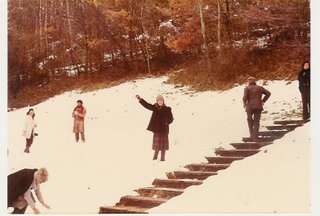
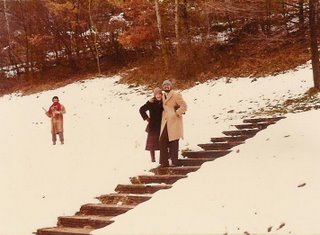


"SNOW GAMES - Highway Vienna - Salzburg"
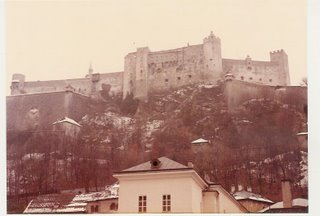

"HOHENSALZBURG FORTRESS, built in 1077, is the largest, fully-preserved fortress in central Europe, and was never conquered by enemy troops. It can be reached by a funicular built in 1892"
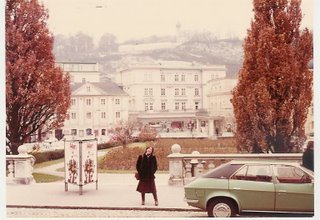
"MARKTPLATZ - Mozart lived nearby"
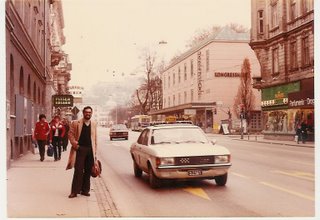

"RAINERSTRASSE, A main thoroughfare in Salzburg"
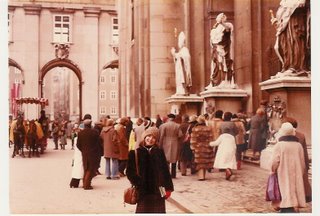
"CATHEDRAL - The first cathedral was built in 767, consecrated in 774 to St. Virgil and St. Rupert, and was destroted by fire. The rest of the story is on Blogtrotter Revival, the 80's, at Zurich, Salzburg - February 1981
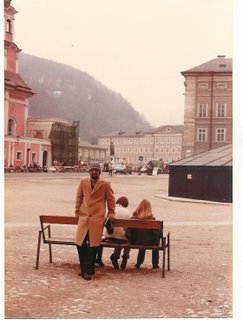
"MOZART SQUARE - The statue is by Ludwig Schwanthaler, and was unveiled on September 5, 1842"
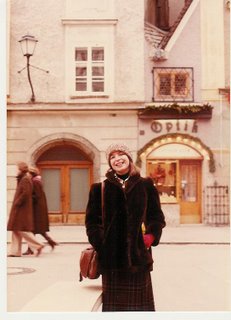
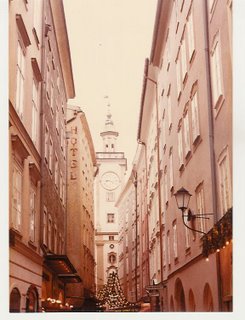
"SHOPPING LANES - Getreidegasse, probably Salzburg's most famous shopping lane, Judengasse and others have high and narrow houses tight together, as well as the famous wrought iron guild signs"

"MOZART'S BIRTHPLACE - Getreidegasse 9, today a museum, is where Wolfgang Amadeus Mozart was born on January 27, 1756. His family lived here from 1747 to 1773"
***
HERE WE COME TO THE END OF THE 70'S TROTTING. THERE IS MORE AT THE BLOGTROTTER REVIVAL, THE 80'S!!!





"SNOW GAMES - Highway Vienna - Salzburg"


"HOHENSALZBURG FORTRESS, built in 1077, is the largest, fully-preserved fortress in central Europe, and was never conquered by enemy troops. It can be reached by a funicular built in 1892"

"MARKTPLATZ - Mozart lived nearby"


"RAINERSTRASSE, A main thoroughfare in Salzburg"

"CATHEDRAL - The first cathedral was built in 767, consecrated in 774 to St. Virgil and St. Rupert, and was destroted by fire. The rest of the story is on Blogtrotter Revival, the 80's, at Zurich, Salzburg - February 1981

"MOZART SQUARE - The statue is by Ludwig Schwanthaler, and was unveiled on September 5, 1842"


"SHOPPING LANES - Getreidegasse, probably Salzburg's most famous shopping lane, Judengasse and others have high and narrow houses tight together, as well as the famous wrought iron guild signs"

"MOZART'S BIRTHPLACE - Getreidegasse 9, today a museum, is where Wolfgang Amadeus Mozart was born on January 27, 1756. His family lived here from 1747 to 1773"
***
HERE WE COME TO THE END OF THE 70'S TROTTING. THERE IS MORE AT THE BLOGTROTTER REVIVAL, THE 80'S!!!
Tuesday, July 18, 2006
VIENNA AT ITS BEST! - NOVEMBER 1979
GROUP STROLL!
In November 1979, Austria national team was going to play a football (soccer) match with Portugal in Lisbon; so the Austrians chartered (and fully paid) a Boeing 747 from the Portuguese airline TAP (Air Portugal) to bring them here, and return to Vienna after the match. The plane was flying empty from Lisbon to Vienna to pick the fans, and then from Vienna to Lisbon on the return flight after the match. This was an opportunity for a very good deal profiting from the fact that the airplane was already paid. So a group was joined, and landed in Vienna!

"SCHÖNBRUNN - La Hermosa Fuente, as our Spanish speaking guide would call it. Mr. Gilbert looks great in front of the palace. The rest of the group heads to the main entrance, trying to avoid the light rain"

"SCHÖNBRUNN - After the visit. The ladies' umbrellas add some colour to the photo"

"RATHAUS - The 1883 neo-Gothic building from Friedrich von Schmidt - the Vienna city hall -, is one of the most important secular buildings in town. The façade is dominated by the central tower (198 meter high), crowned by a 3 meter high statue of the «Eisener Rathausman» - The Iron Knight of the City Hall"

"CHRISTMAS MARKET - In the morning. Fortunately nobody was having Glühwein!"

"MARIA THERESIA SQUARE - Al and Gilbert enjoy the stop of the rain, near the Empress"

"THE RING - Trying to cross the Ring - a 4 kilometre long Boulevard, initiated by Emperor Franz Joseph I in December 1857, which circles the city centre - is not an easy task: no Austrian would dare to disrespect the red light! From left to right, Zé, Marília, Al, Gilbert and Trotter: the rain was back!"

"HOFBURG - Originally a medieval castle, was extended and saw its glory with the Habsburg's power. Nowadays it hosts the Imperial Treasury, the National Library, the Etnography Museum and the world famous «Spanische Hofreitschule» - the Spanish Riding School. The «Heldenplatz» - Heroes Square (photo) -, is one of Austria's symbols"

"GRABEN is the hub of Vienna. It became the fist pedestrian zone in 1971"

"PESTSÄULE - In Graben we can see the «Pestsäule» or Plague Pillar, also called Trinity Pillar. This was raised in the middle of the Graben by Leopold the 1st, as a sign of gratitude by the end of the 1679 plague, which took the life of either eighty or one hundred fifty thousand Viennese, depending on the estimates"

"CATHEDRAL - St. Stephen's Cathedral, built in 1147 and with a 136 meter high tower, was for a long time the highest building in Europe. It marks the city centre, and is a must see to any visitor to Vienna (unless you're only coming for an OPEC or UN meeting, and leave town at the end of the day)"

"KAERTNERSTRASSE - Vienna's central shopping street. Nearby you have Sacher Hotel, and Sachertorte; but, at least for my taste, you are much better off heading down the Ring to the Imperial Hotel, and having Imperialtorte!"

"OPERA - Group photo with Luís, Al, Miga, Gilbert, Trotter, Marilia and Zé. Guida took it.
The Vienna Opera House is famous for its first-class opera performances, as well as for hosting the Vienna Philharmonic Orchestra. As we had not much time, could not see the entire performance, and there were only very few tickets left, we bought tickets for the Gallery. The cost was roughly the price of a tram ticket, the view was restricted - we could only see half of the stage - but the first Act of Wagner's «Meistersinger von Nürnberg» was sublime!"

"ALBERTINA PLATZ - The Albertina palace is 12 metres above the city level. It hosts the Albertina Museum, which has one of the largest and most beautiful graphic collections in the world, with 70.000 drawings and more than one million graphic prints. From Leonardo to Warhol, one can also see works from Michelangelo, Raphael, Rembrandt, Rubens, Manet, Cézanne, but the most impressive was the collection of Dürer's works!"

"WALKING down the Parkring. The Ring Boulevard was inaugurated on May 1st, 1865 and with its trees and monumental buildings is one of the most beautiful boulevards in Europe"

"SCHWARZENBERG PLATZ - Behind the Equestrian statue, there is a Russian Memorial, and we can see the Belvedere Palaces. Not a great shot, anyhow..."

"RINK, just behind the Intercontinental Hotel. Many years later I had a room with a view to the Rink. On the other side is the Stadtpark!"
In November 1979, Austria national team was going to play a football (soccer) match with Portugal in Lisbon; so the Austrians chartered (and fully paid) a Boeing 747 from the Portuguese airline TAP (Air Portugal) to bring them here, and return to Vienna after the match. The plane was flying empty from Lisbon to Vienna to pick the fans, and then from Vienna to Lisbon on the return flight after the match. This was an opportunity for a very good deal profiting from the fact that the airplane was already paid. So a group was joined, and landed in Vienna!

"SCHÖNBRUNN - La Hermosa Fuente, as our Spanish speaking guide would call it. Mr. Gilbert looks great in front of the palace. The rest of the group heads to the main entrance, trying to avoid the light rain"

"SCHÖNBRUNN - After the visit. The ladies' umbrellas add some colour to the photo"

"RATHAUS - The 1883 neo-Gothic building from Friedrich von Schmidt - the Vienna city hall -, is one of the most important secular buildings in town. The façade is dominated by the central tower (198 meter high), crowned by a 3 meter high statue of the «Eisener Rathausman» - The Iron Knight of the City Hall"

"CHRISTMAS MARKET - In the morning. Fortunately nobody was having Glühwein!"

"MARIA THERESIA SQUARE - Al and Gilbert enjoy the stop of the rain, near the Empress"

"THE RING - Trying to cross the Ring - a 4 kilometre long Boulevard, initiated by Emperor Franz Joseph I in December 1857, which circles the city centre - is not an easy task: no Austrian would dare to disrespect the red light! From left to right, Zé, Marília, Al, Gilbert and Trotter: the rain was back!"

"HOFBURG - Originally a medieval castle, was extended and saw its glory with the Habsburg's power. Nowadays it hosts the Imperial Treasury, the National Library, the Etnography Museum and the world famous «Spanische Hofreitschule» - the Spanish Riding School. The «Heldenplatz» - Heroes Square (photo) -, is one of Austria's symbols"

"GRABEN is the hub of Vienna. It became the fist pedestrian zone in 1971"

"PESTSÄULE - In Graben we can see the «Pestsäule» or Plague Pillar, also called Trinity Pillar. This was raised in the middle of the Graben by Leopold the 1st, as a sign of gratitude by the end of the 1679 plague, which took the life of either eighty or one hundred fifty thousand Viennese, depending on the estimates"

"CATHEDRAL - St. Stephen's Cathedral, built in 1147 and with a 136 meter high tower, was for a long time the highest building in Europe. It marks the city centre, and is a must see to any visitor to Vienna (unless you're only coming for an OPEC or UN meeting, and leave town at the end of the day)"

"KAERTNERSTRASSE - Vienna's central shopping street. Nearby you have Sacher Hotel, and Sachertorte; but, at least for my taste, you are much better off heading down the Ring to the Imperial Hotel, and having Imperialtorte!"

"OPERA - Group photo with Luís, Al, Miga, Gilbert, Trotter, Marilia and Zé. Guida took it.
The Vienna Opera House is famous for its first-class opera performances, as well as for hosting the Vienna Philharmonic Orchestra. As we had not much time, could not see the entire performance, and there were only very few tickets left, we bought tickets for the Gallery. The cost was roughly the price of a tram ticket, the view was restricted - we could only see half of the stage - but the first Act of Wagner's «Meistersinger von Nürnberg» was sublime!"

"ALBERTINA PLATZ - The Albertina palace is 12 metres above the city level. It hosts the Albertina Museum, which has one of the largest and most beautiful graphic collections in the world, with 70.000 drawings and more than one million graphic prints. From Leonardo to Warhol, one can also see works from Michelangelo, Raphael, Rembrandt, Rubens, Manet, Cézanne, but the most impressive was the collection of Dürer's works!"

"WALKING down the Parkring. The Ring Boulevard was inaugurated on May 1st, 1865 and with its trees and monumental buildings is one of the most beautiful boulevards in Europe"

"SCHWARZENBERG PLATZ - Behind the Equestrian statue, there is a Russian Memorial, and we can see the Belvedere Palaces. Not a great shot, anyhow..."

"RINK, just behind the Intercontinental Hotel. Many years later I had a room with a view to the Rink. On the other side is the Stadtpark!"
Friday, July 14, 2006
WIENER WALZER - NOVEMBER 1979
MONUMENTS, STATUES, AND MUSIC

"SCHÖNBRUNN - Schönbrunn Palace has 1441 rooms, and is one of the most beautiful Baroque monuments in Austria. Build to rival Versailles near Paris, the lack of funds, however, did not permit the Habsburgs to match the French Palace. Franz Joseph was born here and spent his last years in Scönbrunn. His wife - Elisabeth of Wittelsbach, aka Sissi - also lived here for a while.
The palace and its wonderful gardens (photo) were also included in the UNESCO's world heritage list"

"MARIA THERESIA - Archduchess of Austria, and Queen of Hungary and Bohemia - was one of the most powerful rulers of her time. She was the first and only female head of the Habsburg dynasty. The building behind the statue is the Museum of Natural History, built in Italian Renaissance style"
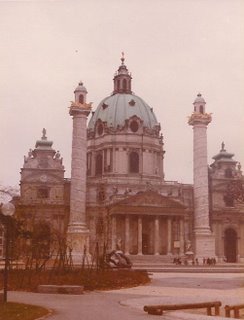
"KARLSKIRCHE - A spectacular church, with a much wide façade resembling a Greek temple, is dedicated to saint Karl Borromeo and is the largest Baroque cathedral north of the Alps. The 72 m high dome is marvellously painted inside"

"KARLS COLUMN - In front of Karlskirche there are two colums, similar to the Trajan column in Rome (see Roma Cittá Aperta), with an allegoric representation of the life of saint Karl Borromeo"
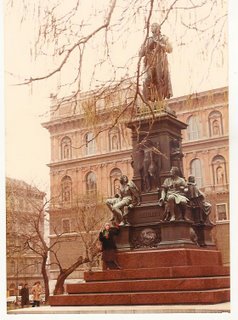
"SCHILLER - Johann Christoph Friedrich von Schiller, the German poet and dramatist, was born in Marbach in 1759 and created links to the music. His Ode «An die Freude» (Ode to Joy) was incorporated in the final movement of Beethoven's Ninth Symphony (1823). In 1972, the Council of Europe adopted it as the anthem of Europe, and in 1985, it was adopted by EU heads of State and government as the official anthem of the European Union, expressing the European ideals of freedom, peace and solidarity. Furthermore, many of its plays were adopted by Verdi for his operas - Die Jungfrau von Orleans (Giovanna d'Arco), Die Räuber (I Masnadieri), Kabale und Liebe (Luisa Miller), Wallensteins Lager (La Forza del Destino), Don Carlos, Infant von Spanien (Don Carlos). And Puccini used Schiller's version of Gozzi's Turandot for his opera"

"BRAHMS - One of the icons of romantic music, was born in Hamburg in 1833 but lived most of his life in Vienna. Somebody once said: «Sauerkraut war genug; Brahms ist zu viel...!»"
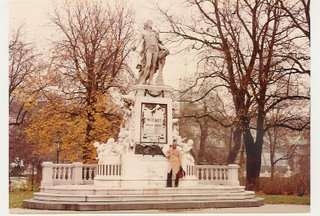
"MOZART (1756-1791) - On the contrary, Mozart is never «too much». Having started his musical education at the age of 4, he performed (when he was 6) at the Hall of Mirrors at Schloss Schönnbrunn and enchanted Empress Maria Theresia and her family. At the age of 25, Mozart moved to Vienna, where he married Constanze Weber, wrote most of his music. The statue in Burggarten is very handsome"
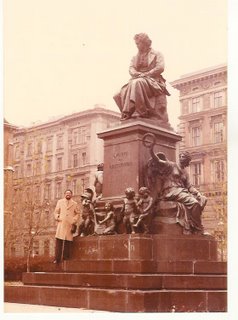
"BEETHOVEN (1770-1827) - had to have a statue in Vienna. Born in Bonn, he moved to Vienna in his early twenties, and studied there with Joseph Haydn. Though starting to lose his hearing by his late twenties, he continued to produce music masterpieces, including the Ninth Symphony when his deafness was absolute"

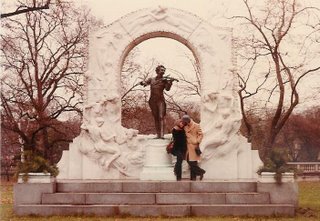
"JOHANN STRAUSS II - (aka Johann Strauss son, Johann Strauss the Younger, Johann Strauss Jr., or Johann Sebastian Strauss - 1825–1899) - was the king of waltzes, author of «The Blue Danube», and probably the most known of the Austrian and Viennese composers. His bronze memorial in the Stadtpark was revealed to the public - gilded - on 26 June 1921. In 1935, the gilding was removed (wise decison), but in 1991 it was layed on again (an awful decision, I would say)"
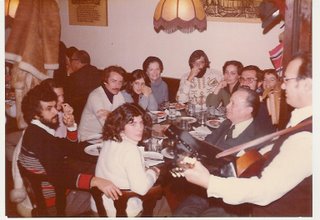
"GRINZING - Different music, but same joy!"

"SCHÖNBRUNN - Schönbrunn Palace has 1441 rooms, and is one of the most beautiful Baroque monuments in Austria. Build to rival Versailles near Paris, the lack of funds, however, did not permit the Habsburgs to match the French Palace. Franz Joseph was born here and spent his last years in Scönbrunn. His wife - Elisabeth of Wittelsbach, aka Sissi - also lived here for a while.
The palace and its wonderful gardens (photo) were also included in the UNESCO's world heritage list"

"MARIA THERESIA - Archduchess of Austria, and Queen of Hungary and Bohemia - was one of the most powerful rulers of her time. She was the first and only female head of the Habsburg dynasty. The building behind the statue is the Museum of Natural History, built in Italian Renaissance style"

"KARLSKIRCHE - A spectacular church, with a much wide façade resembling a Greek temple, is dedicated to saint Karl Borromeo and is the largest Baroque cathedral north of the Alps. The 72 m high dome is marvellously painted inside"

"KARLS COLUMN - In front of Karlskirche there are two colums, similar to the Trajan column in Rome (see Roma Cittá Aperta), with an allegoric representation of the life of saint Karl Borromeo"

"SCHILLER - Johann Christoph Friedrich von Schiller, the German poet and dramatist, was born in Marbach in 1759 and created links to the music. His Ode «An die Freude» (Ode to Joy) was incorporated in the final movement of Beethoven's Ninth Symphony (1823). In 1972, the Council of Europe adopted it as the anthem of Europe, and in 1985, it was adopted by EU heads of State and government as the official anthem of the European Union, expressing the European ideals of freedom, peace and solidarity. Furthermore, many of its plays were adopted by Verdi for his operas - Die Jungfrau von Orleans (Giovanna d'Arco), Die Räuber (I Masnadieri), Kabale und Liebe (Luisa Miller), Wallensteins Lager (La Forza del Destino), Don Carlos, Infant von Spanien (Don Carlos). And Puccini used Schiller's version of Gozzi's Turandot for his opera"

"BRAHMS - One of the icons of romantic music, was born in Hamburg in 1833 but lived most of his life in Vienna. Somebody once said: «Sauerkraut war genug; Brahms ist zu viel...!»"

"MOZART (1756-1791) - On the contrary, Mozart is never «too much». Having started his musical education at the age of 4, he performed (when he was 6) at the Hall of Mirrors at Schloss Schönnbrunn and enchanted Empress Maria Theresia and her family. At the age of 25, Mozart moved to Vienna, where he married Constanze Weber, wrote most of his music. The statue in Burggarten is very handsome"

"BEETHOVEN (1770-1827) - had to have a statue in Vienna. Born in Bonn, he moved to Vienna in his early twenties, and studied there with Joseph Haydn. Though starting to lose his hearing by his late twenties, he continued to produce music masterpieces, including the Ninth Symphony when his deafness was absolute"


"JOHANN STRAUSS II - (aka Johann Strauss son, Johann Strauss the Younger, Johann Strauss Jr., or Johann Sebastian Strauss - 1825–1899) - was the king of waltzes, author of «The Blue Danube», and probably the most known of the Austrian and Viennese composers. His bronze memorial in the Stadtpark was revealed to the public - gilded - on 26 June 1921. In 1935, the gilding was removed (wise decison), but in 1991 it was layed on again (an awful decision, I would say)"

"GRINZING - Different music, but same joy!"
Wednesday, July 12, 2006
TERCEIRA - AÇORES - AUGUST 1979
REVISITING TERCEIRA
Terceira, with a surface area of 382 km2, is the third largest island of the Azores archipelago (after São Miguel and Pico), and the second most populated (with 55000 inhabitants). It is situated approximately 90 miles of São Miguel and 66 miles off Faial, at 27º19' longitude West and 38º44' latitude North. It is probably best known for its air base at Lajes, where some decisions were taken that influenced our current lives, rather than for the fact that its capital city - Angra do Heroismo - has its historical centre classified as a UNESCO World Heritage Site. Having lived in Angra from September 1954 through May 1955, this trip had a lot of a revival journey!
The photos were taken before the terrible earthquake that stroke the Island on January 1st, 1980, which destroyed many beautiful buildings in the town centre. However, reconstruction helped to keep its ancient flavour...
***
ANGRA
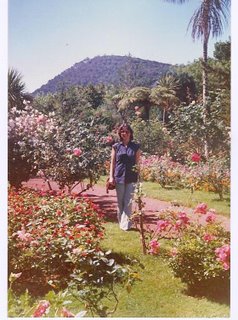
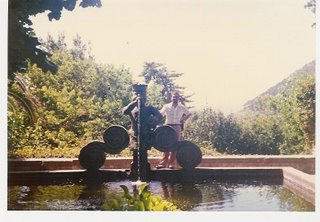

"DUQUE DA TERCEIRA GARDEN - The garden in Angra is a beautiful one. The fountain was most impressive when seen at the age of five!"

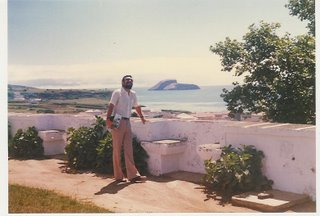
"MEMÓRIA - The views from the top of the garden are awesome"

"MOUNT BRASIL - providing one of the sides of the Angra Bay, it was classified as a Protected Landscape. It is one of the best known images of Terceira"

"ANGRA - This is my favourite photo from this trip. Seen from the top of the garden, Angra looks as beautiful as it is"

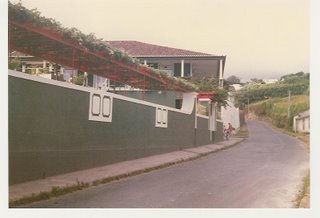
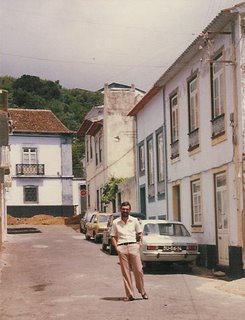
"MEMORIES FROM 1954/1955 - People, streets and houses from when I was five"
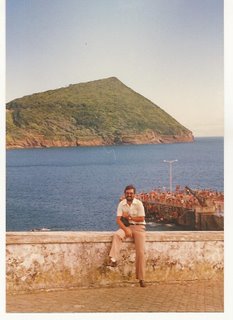
"SILVEIRA BEACH - The beach is not the reason for the trip, but is refreshing in Summer!"
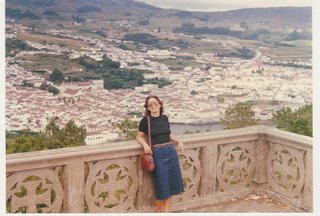


"MOUNT BRASIL - The view from Mount Brasil towards Angra and Terceira Island is beautiful. Gungunhana (1850-1906) - the King of Gaza in Mozambique, from 1885 to 1895, who rebeled and was imprisioned by the Portuguese Army - was exiled in Terceira, where he lived until his death. When we visited , it was said that he was buried in Mount Brasil"
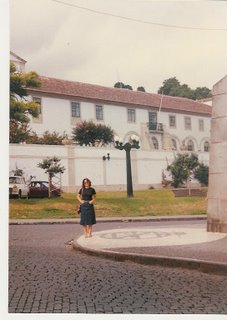
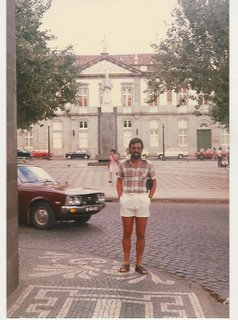

"DOWNTOWN - Beautiful buildings and roofs"
Terceira, with a surface area of 382 km2, is the third largest island of the Azores archipelago (after São Miguel and Pico), and the second most populated (with 55000 inhabitants). It is situated approximately 90 miles of São Miguel and 66 miles off Faial, at 27º19' longitude West and 38º44' latitude North. It is probably best known for its air base at Lajes, where some decisions were taken that influenced our current lives, rather than for the fact that its capital city - Angra do Heroismo - has its historical centre classified as a UNESCO World Heritage Site. Having lived in Angra from September 1954 through May 1955, this trip had a lot of a revival journey!
The photos were taken before the terrible earthquake that stroke the Island on January 1st, 1980, which destroyed many beautiful buildings in the town centre. However, reconstruction helped to keep its ancient flavour...
***
ANGRA



"DUQUE DA TERCEIRA GARDEN - The garden in Angra is a beautiful one. The fountain was most impressive when seen at the age of five!"


"MEMÓRIA - The views from the top of the garden are awesome"

"MOUNT BRASIL - providing one of the sides of the Angra Bay, it was classified as a Protected Landscape. It is one of the best known images of Terceira"

"ANGRA - This is my favourite photo from this trip. Seen from the top of the garden, Angra looks as beautiful as it is"



"MEMORIES FROM 1954/1955 - People, streets and houses from when I was five"

"SILVEIRA BEACH - The beach is not the reason for the trip, but is refreshing in Summer!"



"MOUNT BRASIL - The view from Mount Brasil towards Angra and Terceira Island is beautiful. Gungunhana (1850-1906) - the King of Gaza in Mozambique, from 1885 to 1895, who rebeled and was imprisioned by the Portuguese Army - was exiled in Terceira, where he lived until his death. When we visited , it was said that he was buried in Mount Brasil"



"DOWNTOWN - Beautiful buildings and roofs"
Subscribe to:
Comments (Atom)